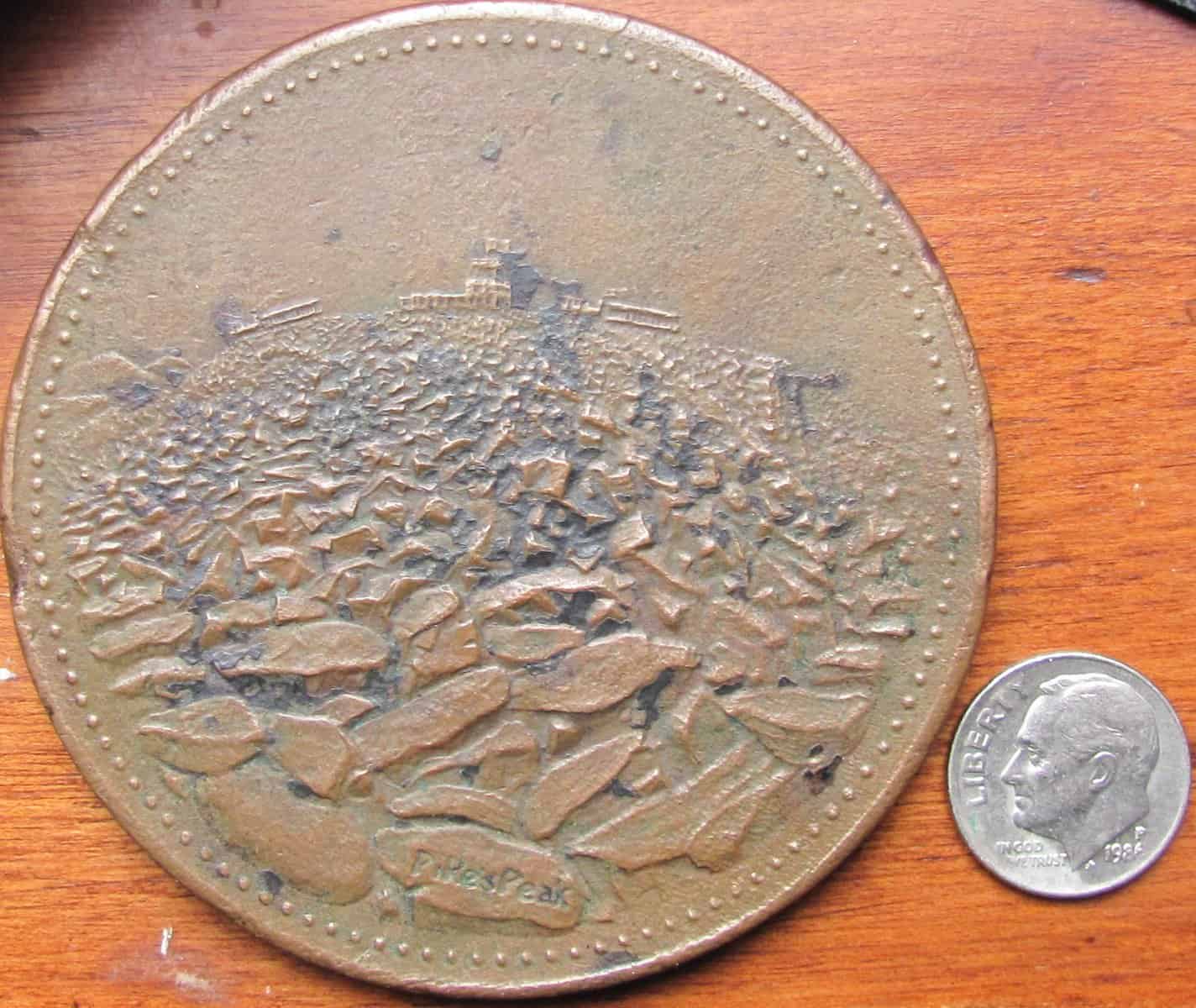I grew up on High Street in Chester in the 1950s and 60s. The wooden swinging bridge on School Street was the shortest route to downtown Chester from High Street. All of us kids used it.

One summer day, 60 years ago, I crossed the footbridge from School Street and started up the hill to High Street. The night before was a severe thunderstorm. The sudden runoff from High Street wore gullies in the walkway up the hill to High Street.
Being a kid, and watching where I stepped, I noticed a washout about 10 inches deep. I looked down in the washout and saw what looked like a large coin partially exposed. I dug it out. I didn’t know what it was, but it wasn’t a coin. It measures 2-and-three-quarter inches in diameter, is made of bronze, and quite heavy. This was 1962.
I brought it home and cleaned it up enough so I could read it. On the front is a rocky mountain with a building at the top. At the bottom it is stamped “Pikes Peak.” Around the circumference of the reverse it reads “39th National Encampment G.A.R. Denver Sept 1905.” In the center of the reverse is a dedication to those who fought in the Great Rebellion of 1861-1865.
I showed it to several people. No one knew anything about it except my neighbor Herbie Randall. Herbie explained to me that the G.A.R. was the Grand Army of the Republic. The G.A.R was an organization similar to the American Legion today. After the Civil War, many G.A.R. Lodges were formed. It wasn’t uncommon for veterans to have encampments at Gettysburg or other battlefields into the 20th century.
I always wondered how something from Colorado ended up lost in Chester. Colorado Territory was created in 1861. Prior to that date, a few adventurous Southerners had located there to mine for gold and silver.
When war broke out, some Southerners returned to their homes to take up arms. A few however remained in Colorado. Some of these men joined raiding parties.
In 1861 Confederate recruits were sent to Pikes Peak near Denver. At this same time, Confederates were raiding areas of New Mexico, disrupting the Union any way they could. In Colorado, the Confederates robbed miners and gold shipments.
By the standards of the eastern battles of the Civil War, these were minor skirmishes. However, their effect could be financially devastating to the Union.
My thoughts on how this medal ended up in Chester. This medal is from the 39th National Encampment. National encampments were held at other battlefields, including Gettysburg, and were well attended. A veteran visiting the 39th encampment brought this home as a souvenir. What a trip that must have been. The photo with this article is the front of the medal.
The swinging bridge
The swinging bridge on School Street has an interesting history. Here is what I know. The 1938 Hurricane took out the iron vehicle bridge at the end of School Street. Motorists had used this bridge to High Street.
When it was destroyed in 1938, a wooden footbridge was soon built across the river to relieve stranded families on High Street. This first wooden footbridge was short lived. Within a few years it was replaced with steel towers and suspension cables as we have today.
When I was a boy, it was a wooden bridge. As I recall its construction, there were four-inch, or larger, square timbers under the bridge deck. The ends of these four-inch crosspieces extended out maybe six inches on each side. There was a galvanized steel rod from the suspension cable down to the four-inch wooden crosspiece, one on each side. That rod passed through a hole near the end of the wooden crosspiece, secured by nut and washer. The wooden deck was attached to these suspended crosspieces.
I seem to recall it was the Flood of 1927 that took out the covered bridge at this site, but I am not positive. Today, as you cross the steel footbridge, on the High Street side, you will see a man-made rock abutment. This is what remains of the old covered bridge.
As you step off the bridge on that side, look to your right and you’ll see nearby an old stone foundation. As late as 1965 there was a house here.
This week’s old saying is from Winston Churchill: “Fear is a reaction. Courage is a decision.”